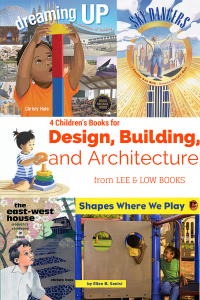Celebrate architecture and design for Archtober with students!
October, or “Archtober” as it is called, marks the 4th annual month-long festival of all things architecture and design in New York City.
 Recommended reading to teach about architecture for students:
Recommended reading to teach about architecture for students:
 Dreaming Up: A Celebration of Building
Dreaming Up: A Celebration of Building
- Lee & Low teacher’s guide
- Reading is Fundamental guide
- Classroom activities from author, Christy Hale
- Lee & Low teacher’s guide
- The Empire State Building lesson plans from Bank Street College of Education
- The Skyscraper Museum educator resources
 The East-West House: Noguchi’s Childhood in Japan
The East-West House: Noguchi’s Childhood in Japan
- Lee & Low teacher’s guide
- Classroom activities from author, Christy Hale
- The Noguchi Museum educator resources
STEM + Literacy Activities:
1. Encourage students to examine the differences between architecture and engineering. How do these two fields depend on each other? What is unique about each field? What do architects contribute to building a structure? What do engineers contribute? For a simplified breakdown of the duties of an architect and an engineer, the New School of Architecture + Design has a clear infographic.
2. Have students in small teams research a well-known structure in their community, city, or state (such as a museum, performing arts center, or place of worship). Who built it and when? For what is the structured used? Where is it located? What is it made of? Why were those materials used? What is special about the design? What challenges did the architect have in creating this structure? In addition to online and print resources, students can interview someone who works at the structure, if possible. After research is complete, students can create a model of the structure, design a poster advertising it to tourists, or write and present a report on the structure to the class.
3. Ask students to imagine that they are architects assigned to design a new school. Describe the materials you will need and what the building will look like. As you think about the design and materials needed, consider the types of spaces children in the school will need to learn, read, eat, study; what you will need to make the building safe and sturdy; and what will make it an attractive place in which to learn.
4. Set up a hands on, or sensory, station with materials from home or a local hardware store that are used to build structures. Examples could be a wood spoon for wood, a cooking pot for steel, etc. Have students touch and record the characteristics of each sample material. Why might an architect use steel instead of wood, or bamboo instead of concrete? Students can make a chart of popular building materials to compare the advantages and disadvantages of each. Have students study the physical characteristics (based on sight, touch, sound, and even smell) of brick, wood, bamboo, clay, concrete, steel, glass, iron, rock, straw, recycled materials, and more. For advanced or older students, topics to compare include cost of the material, availability, resiliency in natural disasters, typical lifetime, flexibility and ability to shape the material, environmental friendliness, and beauty/appeal.
5. Have students study the roles that appeal/beauty, safety, and function/purpose play in the design of a structure. Is one preferable over the other? Why? Do these factors all work together or can they be in conflict with one another? Students can look at one specific structure to see how the architect addressed each of these issues. If possible, ask a local architect or professor from an area college to discuss these factors.
6. Watch PBS’s “Building Big,” a five-part miniseries on bridges, domes, skyscrapers, dams, and tunnels. Each one-hour program explores the different type of structures and what it takes to build them. An educator’s guide of activities from PBS is available online.
7. Lead students in a step-by-step activity to create their own geodesic dome, sandcastle, toothpick structure, or floor plan. Instructions can be found online at the archKIDecture website.
Jill Eisenberg, our Resident Literacy Specialist, began her career teaching English as a Foreign Language to second through sixth graders in Yilan, Taiwan as a Fulbright Fellow. She went on to become a literacy teacher for third grade in San Jose, CA as a Teach for America corps member. She is certified in Project Glad instruction to promote English language acquisition and academic achievement. In her column she offers teaching and literacy tips for educators.





I was just thinking about Dreaming Up again this week. I used it with first grade last year http://readingtl.blogspot.com/2013/10/dreaming-up.html and will use it again this year. I may even use it with other grades too. We are in the midst of a large scale remodel of our school building so the students have been hearing the word architect a lot and are seeing construction on a daily basis from the playground. I will have to get my hands on the other books too. Thanks for the titles!
Hi Crystal-
Thank you for sharing! We love the structures your first graders made after reading Dreaming Up. We are always excited to learn how our titles such as these are being applied in the classroom and are always impressed with the creativity and rigor teachers come up with to engage and challenge learners. Please let us know how you use it again this year or feel free to share the link if you reflect the experience on your blog!